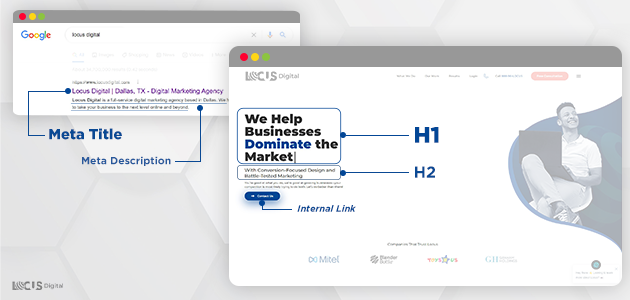Developing a Recruitment Website: A Step-by-Step Guide

Contents
- Why create a recruitment website?
- Researching the market and target audience
- Defining the purpose and goals of your website
- Choosing the right domain name and hosting provider
- Selecting a platform for your website (WordPress, Squarespace, etc.)
- Designing your website with user experience in mind
- Creating compelling content for your website
- Implementing effective SEO strategies to drive traffic to your site
- Integrating social media and other marketing initiatives with your website
- Setting up job listings and applications on your website
- Ensuring compliance with employment laws and regulations
- Measuring the success of your recruitment website through analytics and metrics tracking
- Maintaining and updating your website for optimal performance
- Common mistakes to avoid while developing a recruitment website
Developing a Recruitment Website: A Step-by-Step Guide
Creating a recruitment website is a crucial step in modern recruitment strategies. With the advances in technology and the changing job-seeking behavior of candidates, it is important for businesses to have their own online presence. This article is a step-by-step guide on how to create a recruitment website that is effective in attracting and hiring top talent.
Why create a recruitment website?
The purpose of a recruitment website is to establish an online platform for businesses to showcase their employer brand and provide valuable information to potential job candidates. Having a recruitment website offers numerous benefits, such as:
- Cost-effectiveness - a recruitment website offers an affordable alternative to traditional recruitment methods, such as job postings in newspapers or career fairs
- Increased visibility - a recruitment website provides businesses with the opportunity to reach a wider audience and attract top talent from any part of the world
- Brand Consistency - a recruitment website allows businesses to showcase their unique employer brand, culture, values and mission, which is essential for attracting the right candidates
- Data tracking and analysis - a recruitment website allows businesses to track candidate activities and apply the necessary metrics to assess the success of their recruitment strategies
Researching the market and target audience
Before creating a recruitment website, businesses need to conduct research on the job market and their target audience. This research will help in identifying the gaps in the market and the preferences of job candidates. During the research, considerations should be given to the following factors:
- The current job market trends and the skills required for the job roles being advertised
- The demographics and preferences of the potential audience, including the job locations they are interested in, their salary expectations and the positions they are looking for
- The competitors in the market and what they offer to attract and retain talent
- The employer brand and the unique selling points of the business as an employer.
Defining the purpose and goals of your website
The purpose and goals of the recruitment website should be clearly defined before starting the development process. The main purpose of the website could be to attract top talent, reduce the time taken to fill job vacancies, improve the quality of candidates, or provide information about the employer brand. Goals should be specific, measurable, achievable, relevant, and time-bound. Examples of possible goals include:
- Increase the number of applications received by 20% over the next six months
- Reduce the time to fill job vacancies by 25% over the next year
- Improve the quality of candidates by increasing the number of candidates who meet the job requirements by 50% over the next year
- Reduce recruitment costs by 15% over the next year.
Choosing the right domain name and hosting provider
The choice of domain name and hosting provider is a crucial factor that affects the performance of the website. The domain name should reflect the employer brand and be easy to remember. The hosting provider should offer reliable, scalable and secure hosting services. Factors to consider when choosing a hosting provider include:
- Uptime guarantee and server reliability
- Scalability and flexibility
- Security features such as regular backups, malware scanning, and HTTPS encryption
- Customer support and technical assistance
- Cost and payment options
- Compatibility with the chosen platform for the website.
Selecting a platform for your website (WordPress, Squarespace, etc.)
Choosing the right platform for the website is also essential for the success of the recruitment website. The platform should be user-friendly, secure, and customizable to meet the specific needs of the business. Some popular platforms for recruitment websites include:
- WordPress - The most popular website building platform that is free and open-source, and offers a wide range of features and customization options
- Squarespace - A user-friendly, template-based platform that offers an intuitive drag-and-drop design interface
- Wix - A cloud-based website builder that offers a variety of templates and features to customize the website
- Weebly - A drag-and-drop website builder with a simple interface and a wide range of templates and integrations
- Recruiterbox - A recruitment-specific platform that offers features such as job listings, applicant tracking, and scheduling interviews.
Designing your website with user experience in mind
The design of the recruitment website should be highly intuitive, easy to navigate, and visually appealing. The website should be designed with the target audience in mind and should reflect the employer brand. Key elements of effective website design include:
- A clear and concise navigation menu
- A simple and intuitive layout that is easy to scan
- A responsive design that is compatible with all devices and screen sizes
- High-quality images, videos, and graphics that reflect the employer brand
- Clear and compelling calls-to-action to encourage job seekers to apply or learn more about the company.
Creating compelling content for your website
The content on the recruitment website should be well written, informative, and engaging. It should provide job seekers with valuable information about the employer brand, job roles, salary packages, benefits, culture, and mission. Examples of content that can be included on the website are:
- An 'about us' page that provides information about the company's history, values, and mission
- A 'careers' page that lists the available job roles, job descriptions, and requirements
- A 'culture' page that outlines the company's culture and employee benefits
- Testimonials from current employees that showcase the employer brand and culture of the company
- A blog or news section that provides job seekers with relevant and up-to-date information about the industry and job roles.
Implementing effective SEO strategies to drive traffic to your site
Search engine optimization (SEO) is the process of improving the visibility and ranking of the website on search engine result pages (SERPs). Employing effective SEO strategies can help drive more traffic to the website and increase the number of applicants. Examples of effective SEO strategies include:
- Keyword research and optimization to ensure that the website appears in search results for relevant job-related terms
- Creating high-quality and relevant content that attracts and engages job seekers
- Optimizing the website's navigation, metadata, and images for search engines
- Building internal and external links that improve the website's ranking and authority
- Employing local SEO strategies by optimizing the website for location-based searches, such as 'jobs in New York City.'
Integrating social media and other marketing initiatives with your website
Social media and other marketing initiatives can help increase the visibility and reach of the recruitment website. Incorporating social media and other marketing strategies into the recruitment website can help attract more job seekers and improve the quality of applicants. Examples of social media and marketing strategies to integrate with the recruitment website include:
- Sharing job postings and content on social media platforms such as LinkedIn, Twitter, and Facebook
- Creating targeted ads and campaigns to reach potential candidates
- Offering referral incentives to encourage employees to share job postings with their network
- Participating in career fairs and other recruiting events and providing information about the recruitment website to potential job candidates
- Providing job seekers with resources and tools such as resume templates, interview guidelines, and job search tips.
Setting up job listings and applications on your website
The website should include an structured job listings section that provides job seekers with detailed information about each job role, such as the job description, requirements, and application instructions. The job application process should be straightforward and easy to navigate, and it should be linked to the applicant tracking system (ATS) used by the business. Key elements of an effective job application form include:
- Step-by-step guidance with instructions on how to complete the application form
- A simple, user-friendly layout that is optimized for all devices
- A customizable form that requests only relevant information from job seekers
- The ability to attach a resume, cover letter, or other supporting documents
- Notifications and automatic responses to let candidates know that their application has been received and what the next steps are
- Easy integration with the business's ATS.
Ensuring compliance with employment laws and regulations
When developing a recruitment website, it is important to ensure that it is compliant with labor laws and regulations. Failure to comply with these regulations can lead to legal issues and damage the employer brand. Some important considerations include:
- The legal requirements for job postings and applications in the relevant jurisdictions
- The use of pre-employment screening tools, such as criminal background checks, and compliance with the Fair Credit Reporting Act (FCRA)
- The use of gender-neutral language and the avoidance of discriminatory language or practices
- The protection of personal information and compliance with data privacy laws such as the General Data Protection Regulation (GDPR) or the California Consumer Privacy Act (CCPA).
Measuring the success of your recruitment website through analytics and metrics tracking
The effectiveness of the recruitment website should be measured and analyzed regularly to assess the success of the recruitment strategies. Key performance indicators (KPIs) that can be measured using analytics and metrics include:
- Website traffic and page views
- Bounce rate and conversion rate
- The job application rate and quality
- Time-to-hire and cost-to-hire
- Candidate retention and performance
- Employer brand perception and reputation.
Maintaining and updating your website for optimal performance
It is important to maintain and regularly update the recruitment website to ensure that it is functioning properly and offering a positive user experience. Regular maintenance activities could include:
- Checking for broken links and fixing them
- Optimizing images and videos to improve website speed
- Testing the website for functionality and usability on different devices and browsers
- Updating the website's software and plugins to maintain security and improve performance
- Adding new content and features to keep the website fresh and engaging for job seekers.
Common mistakes to avoid while developing a recruitment website
Some common mistakes that businesses can make when developing a recruitment website include:
- Not having a clear purpose and goals for the website
- Choosing an unprofessional or irrelevant domain name
- Using poor-quality images and videos that do not reflect the employer brand
- Not optimizing the website for search engines and search results
- Providing a poor user experience due to poor website design or functionality
- Not complying with labor laws and regulations regarding job postings and the applicant screening process
- Not regularly updating the website and its content
- Not measuring the effectiveness of the website and analyzing KPIs.
In conclusion, developing a recruitment website requires careful planning, consideration, and execution to ensure that it is effective in attracting and hiring top talent. By following these steps and avoiding common mistakes, businesses can create a recruitment website that is engaging, informative, and successful.


